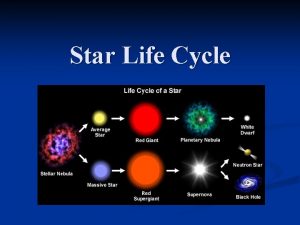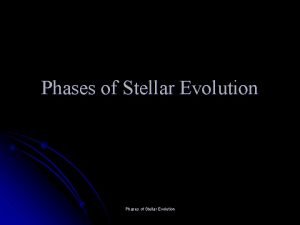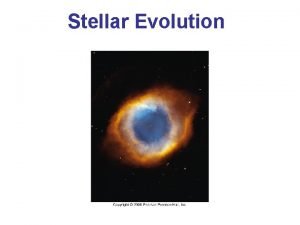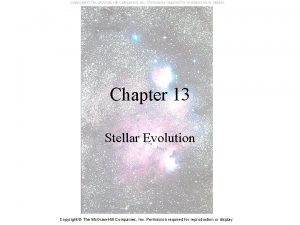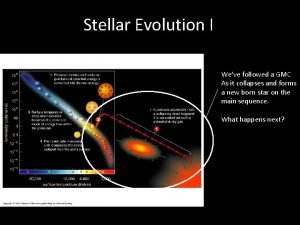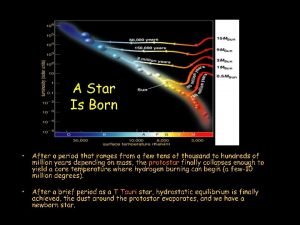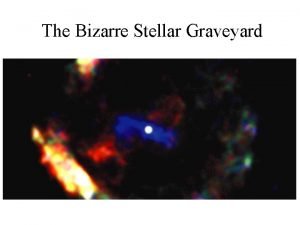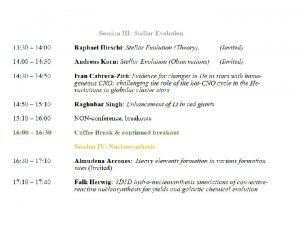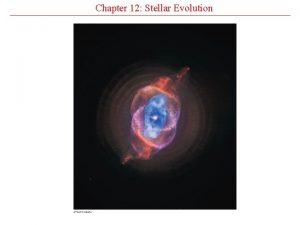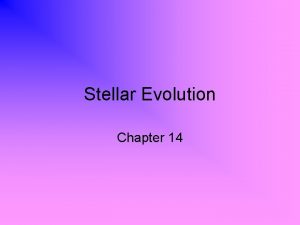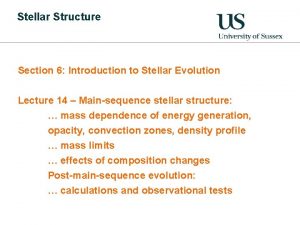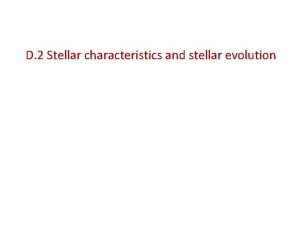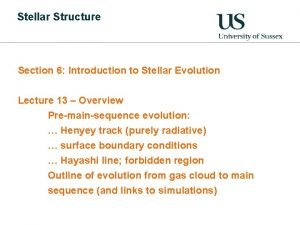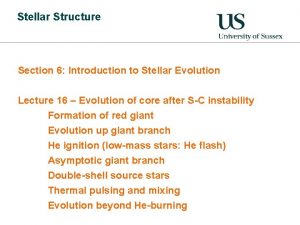Stellar Evolution Online Lesson What are Stars Stars













- Slides: 13

Stellar Evolution On-line Lesson

What are Stars? • Stars are large balls of hot gas. • They look small because they are a long way away, but in fact many are bigger and brighter than the Sun. • The heat of the star is made in the centre by nuclear fusion reactions. • There are lots of different colours and sizes of star.

How are stars made? • Stars are made (or “born”) in giant clouds of dust and gas called nebulas. • Gravity begins to pull the dust and gas together forming…. . a protostar-a star in the earliest stage of its lifecycle.

What happens next? • Once a star is “turned on” it is called a main sequence star. • Within a star nuclear fusion reactions are producing heat. .

The life of a star • During its “life” a star will not change very much. • However, different stars are different colour, size and brightness. • The bigger a star, the hotter and brighter it is. Hot stars are Blue. Smaller stars are less bright, cooler and Red. • Because they are so hot, the bigger stars actually have shorter lives than the small, cool ones.

• After the protostar step the evolution of a star depends on its mass. • Low-mass or medium mass stars have one pathway • High-mass stars have a different pathway.

Low mass or medium mass stars How does a star “die”? • Eventually, the hydrogen (the “fuel” for the nuclear fusion) in the centre of the star will run out and no new heat will be made. • This makes the star cool down, making the star look much bigger and redder. • This star is called a Red Giant. Antares – a Red Giant

Love and Medium mass stars The end of a Sun-like star • The outer parts of the star (that formed the Red Giant) then drift off into space and cool down making a Planetary Nebula. • Planetary nebulae have nothing to do with planets, of course, they just look a bit like them in small telescopes! • Here you can see a planetary nebula called M 57 with its White Dwarf in the middle. Image from the Liverpool Telescope

Low or medium mass star • As a low or medium mass star dies the outer parts of a red giant drift into space called a planetery nebula • The hot core left behind is called a white dwarf. • When the white dwarf runs out of fuel it dies and becomes a black dwarf.

High mass star The end of a massive star • When a high mass star runs out of fuel it begins to cool and forms what is called a Red Super Giant Simulation of the Death of the massive Star • Finally, there are • However, eventually even the biggest stars run out of fuel and finally collapse. • For the biggest stars, this collapse causes a huge explosion called a Supernova! A Supernova can be brighter than an entire galaxy of 100, 000, 000 stars!

High Mass stars What is left after a Supernova? • Because the star was so big, the collapse does not stop even with a White Dwarf, but an even more dense object called a Neutron Star is made. • Sometimes the collapse cannot stop at all and a Black Hole is made, from which not even light can escape!

Image from the European Southern Observatory Very Large Telescope The Crab Supernova Remnant On-line Lessons: The Birth and Death of Stars

On-line Lessons: The Birth and Death of Stars White Dwarf and Planetary Nebula Collapsing cloud A new star Sun-like stars Supernova Remnant and Neutron Star Red Giant Massive stars Birth and Death of Stars - Summary

